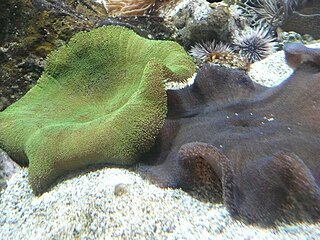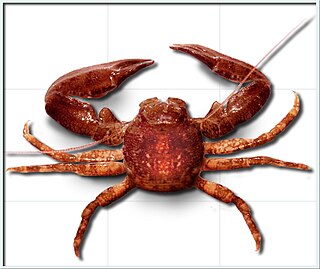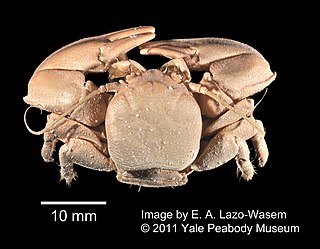
Crabs are decapod crustaceans of the infraorder Brachyura, which typically have a very short projecting "tail" (abdomen), usually hidden entirely under the thorax. They live in all the world's oceans, in freshwater, and on land, are generally covered with a thick exoskeleton, and have a single pair of pincers. They first appeared during the Jurassic Period.

Hermit crabs are anomuran decapod crustaceans of the superfamily Paguroidea that have adapted to occupy empty scavenged mollusc shells to protect their fragile exoskeletons. There are over 800 species of hermit crab, most of which possess an asymmetric abdomen concealed by a snug-fitting shell. Hermit crabs' soft (non-calcified) abdominal exoskeleton means they must occupy shelter produced by other organisms or risk being defenseless.

The Decapoda or decapods are an order of crustaceans within the class Malacostraca, including many familiar groups, including crabs, lobsters, crayfish, shrimp, and prawns. Most decapods are scavengers. The order is estimated to contain nearly 15,000 extant species in around 2,700 genera, with around 3,300 fossil species. Nearly half of these species are crabs, with the shrimp and Anomura including hermit crabs, porcelain crabs, squat lobsters making up the bulk of the remainder. The earliest fossils of the group date to the Devonian.

Horseshoe crabs are marine and brackish water arthropods of the family Limulidae and the only living members of the order Xiphosura. Despite their name, they are not true crabs or crustaceans: they are chelicerates, most closely related to arachnids such as spiders, ticks, and scorpions.

Anomura is a group of decapod crustaceans, including hermit crabs and others. Although the names of many anomurans include the word crab, all true crabs are in the sister group to the Anomura, the Brachyura.

Carcinisation is a form of convergent evolution in which non-crab crustaceans evolve a crab-like body plan. The term was introduced into evolutionary biology by L. A. Borradaile, who described it as "the many attempts of Nature to evolve a crab".

Porcelain crabs are decapod crustaceans in the widespread family Porcellanidae, which superficially resemble true crabs. They have flattened bodies as an adaptation for living in rock crevices. They are delicate, readily losing limbs when attacked, and use their large claws for maintaining territories. They first appeared in the Tithonian age of the Late Jurassic epoch, 145–152 million years ago.

Cancer pagurus, commonly known as the edible crab or brown crab, is a species of crab found in the North Sea, North Atlantic Ocean, and perhaps the Mediterranean Sea. It is a robust crab of a reddish-brown colour, having an oval carapace with a characteristic "pie crust" edge and black tips to the claws. A mature adult may have a carapace width up to 25 centimetres and weigh up to 3 kilograms. C. pagurus is a nocturnal predator, targeting a range of molluscs and crustaceans. It is the subject of the largest crab fishery in Western Europe, centred on the coasts of the British Isles, with more than 60,000 tonnes caught annually.

The Florida stone crab is a crab found in the western North Atlantic, from Connecticut to Colombia, including Texas, the Gulf of Mexico, Belize, Mexico Jamaica, Cuba, The Bahamas, and the East Coast of the United States. The crab can also be found in and around the salt marshes of South Carolina and Georgia. It is widely caught for food. The closely related species Menippe adina is sometimes considered a subspecies – they can interbreed, forming hybrids – and they are treated as one species for commercial fishing, with their ranges partly overlapping. The two species are believed to have diverged approximately 3 million years ago.

Stichodactyla haddoni, commonly known as Haddon's sea anemone, is a species of sea anemone belonging to the family Stichodactylidae. It is found in the Indo-Pacific area.

Porcellana platycheles, the broad-clawed porcelain crab, is a species of porcelain crab from the family Porcellanidae. It is found on the coasts of the eastern Atlantic Ocean and in the Mediterranean Sea

Pisidia longicornis, the long-clawed porcelain crab, is a species of porcelain crab that lives in the north-eastern Atlantic Ocean. It varies from reddish to white, and grows to a carapace width of 1 cm (0.4 in). It was first named by Carl Linnaeus in 1767, although the etymology remains unclear.

Petrolisthes eriomerus is a species of marine porcelain crab found in the eastern Pacific Ocean. It is commonly known as the flattop crab. It is a flattened, rounded animal, with a carapace up to 20 mm (0.8 in) across. It is a filter feeder, and also sweeps food from rocks.
Jurellana tithonia, the only species in the genus Jurellana, is a fossil crab. It was found in limestone rocks from the Ernstbrunn Formation in Austria, which have been dated to the Tithonian. It was originally thought to be the world's oldest porcelain crab, but was later determined to actually be a true crab.

Allopetrolisthes spinifrons is a species of porcelain crab. It displays "hypercarcinisation", whereby the resemblance to a true crab is enhanced by sexual dimorphism of the abdomen. It lives along the Pacific coast of Peru and Chile, as a symbiont of a sea anemone.

Porcellana sayana is a species of porcelain crab that lives in the western Atlantic Ocean, often as a commensal of hermit crabs. It is red with white spots, and has a characteristic bulge behind each claw.

Petrolisthes armatus, the green porcelain crab, is a species of small porcelain crab in the family Porcellanidae. It is believed to be native to Brazil but has spread to other parts of the world. Populations in the south eastern part of the United States have increased dramatically and the species is considered to be an invasive species.

Polyonyx gibbesi, the eastern tube crab, is a species of porcelain crab in the family Porcellanidae. It is found in the western Atlantic Ocean.

Polyonyx is a genus of porcelain crabs in the family Porcellanidae. There are at least 42 described species in Polyonyx.

Pachycheles is a genus of porcelain crabs in the family Porcellanidae. There are more than 40 described species in Pachycheles.

















